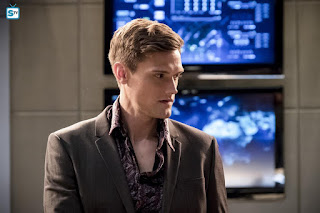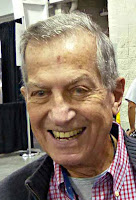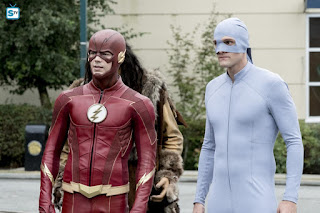The Flash's treatment of Ralph Dibny continues to be debated by viewers of all walks. As this blog has just finished going over the first bunch of stories featuring Ralph in the comics, I can say I actually welcomed seeing the character being reinterpreted with flaws and a character arc. As he was introduced as a possible rogue who turned out to be a recurring guest star superhero in the original comics, the original version of Ralph didn't have a lot of characterization.
Over on Reddit's community for The Flash, user electrickittenshark had quite a bit to say about how they believe Ralph's character will develop in the coming episodes of the show. With their permission, I am quoting large parts of that post below, some editing done:
[Ralph is] an opportunity for Barry to reflect on his own identity as a hero. In "Elongated Journey Into Night" we are introduced to this sleazy, self-centred version of Ralph and throughout the episode Barry keeps stating that Ralph is terrible person who won't change. One of the reasons why Barry is kind of a judgemental douche at first is because his judgment is being tainted by his own painful experiences.
When Ralph turns out to be dirty cop who framed a man for murder, Barry is reminded of how his own father was falsely accused of killing his mother. When Ralph shows up again, Barry who seems to have found peace at this point is reminded of these old wounds. It’s only when Caitlin a character who has struggled with her own shadow self (Killer Frost) calls Barry out, that Barry even considers the possibility that he is in the wrong. Instead of seeing Ralph as an egomaniacal jerk who committed perjury for some kind of glory Barry is forced to see Ralph as a man who had the best of intentions and genuinely believed that he was doing the right thing. Barry ends up being honest about all the bad choices he made to protect the city (e.g. that totally unethical pipeline prison). Ralph Dibny represents Barry’s own selfishness, lack of self-awareness and short-sightedness as a hero.
Dibny states “I was a good cop, I was a good detective…” which implies that he doesn't see himself as a good man now. So, Barry’s initial perception of Ralph is how Ralph actually sees himself. It’s only when Barry
a) calls Ralph out on his crap and forces him to take responsibility for his choices and
b) tells Ralph that he is still and can be a good man that Ralph decides to do something selfless.
Barry suggesting the name ‘Plastic Man’ isn't just a cute little comic book reference, it foreshadows Ralph’s arc. Plastic Man like Ralph is a crook and goofy sleazebag. Ralph’s arc through the season is to transform from Plastic Man to the more moral and compassionate Elongated Man.
In "Girl's Night Out," Ralph continues to act as a shadow self by pushing Barry to go to a strip club and it is because of Ralph’s influence Barry kind of neglects his duties as the Flash. In "When Harry Met Harry," Barry acts as Ralph’s heart and moral compass. This episode continues to highlight Ralph’s fatal flaws: his pride and his stubbornness. There are parallels between Ralph single minded pursuit of Bison at all costs and Ralph’s pursuit of the woman’s murder 5 years ago. In both cases, there is a huge price to pay. For his past case Ralph compromised his morals and committed perjury whereas now he compromised the civilian’s safety and a little girl got hurt. Ralph completely dismisses Barry’s advice at first because of his own pride. He was Barry’s senior after all, but once he sees how much damage he has caused he is wracked with guilt. Barry’s speech about the importance of having a support system and his promise to protect Ralph’s heart is a very pivotal moment.
For five years, Ralph has been completely alone. He had no support system. He hasn't been shown compassion, empathy or friendship for a while. Basically, he is good man who is covered with 50 layers of grime and shit. He needs two things to develop: a) decent support system and b) someone who will call him out on his crap. We see his potential as a caring hero when he visits the girl at the hospital and returns the necklace to the tribe.
Here is where we start to see a pattern:
1) Ralph acts like a selfish dickhead.
2) He gets a metaphorical kick in the balls (i.e. someone tells him he is being stupid and selfish)
3) He also gets a dose of kindness or understanding from someone else.
4) Ralph apologises and takes responsibility for his actions. (Super important!)
5) He reveals more of his ‘heart’ (i.e. his sense of empathy and compassion)
This pattern is repeated in "Don't Run." Ralph’s lack of self-awareness and social skills end up driving Caitlin away. Ralph doesn't realize that his teasing is hurting Caitlin until Cisco tells him to SHUT HIS BIG MOUTH! When Cisco comes back and apologises, Ralph admits that he was a dick (private and public). Just like "When Harry Met Harry," he reveals his heart towards the end of the episode, (i.e decorating the West household.)
I think it's important to highlight how Ralph is treated like an outsider and butt-monkey by Team Flash. He isn’t taken seriously as a private investigator or as a hero. He is not invited to the bachelor party or wedding. Nobody in the lab geeks out over his powers (there are multiple scenes of him showing off his powers and everyone else is just ‘meh’) and no one thinks about asking this expert detective for help. His bland grey costume and lack of a Cisco approved code name symbolizes his lack of identity as a hero and how he isn't being taken seriously.
Here’s what needs to happen next, there has to be an episode where Ralph really proves himself as a hero and a detective. Which will probably happen in "The Elongated Knight Rises." He needs to solidify his identity as a hero and decide what kind of man/hero he wants to be. He needs a mission statement and maybe even his own theme song.
As for Ralph’s sexist behaviour we need to have a genuinely strong woman to call him out on his chauvinistic behaviour by telling Ralph how being a desperate horndog drives women away. This has to be someone who Ralph respects, admires and sees as a friend.
The main point I am trying to make in my long long post is that Ralph’s ability to stretch, bend and twist mirrors his own ability to change and adapt. He may be intolerable now but we still have a lot of episodes left. Who knows he could end up being one of the most likeable characters on the show.
 I really dug electrickittenshark's opinions of Ralph, and when someone suggested that Ralph needs to crack about being able to stretch "everything," they proposed this scene with Sue in the future:
I really dug electrickittenshark's opinions of Ralph, and when someone suggested that Ralph needs to crack about being able to stretch "everything," they proposed this scene with Sue in the future:You know what would be really funny, if his ability to stretch every part of his body was some kind of inside joke between Ralph and Sue.
Scene: Ralph stretches his neck across the room to talk to Sue or give her a kiss.
Caitlin: "How are you not weirded out by...this?"
Sue: "Oh, you get used to it, Ralph is basically a cartoon character. A really handsome cartoon character, mind you. (With a cheeky smile on her face) Plus there are some obvious benifits of being able to stretch every part of your body. He can reach those hard to get places, you know?"
Ralph winks at Sue and they giggle secretly. They know...They know.
Further commenting on the role of a good woman who can help Ralph evolve, they highlighted the relationships Ralph has with the two main female characters on the show:
I think that Iris will be more brutally honest with him about his creepy behaviour and Caitlin will provide her dose of kindness. Or maybe Sue will straigten him out who knows...I have to agree about Ralph's depression. Note that in "Elongated Journey Into Night" when he transforms his gut into abs, he says, "I'm back!" In the following episodes, Ralph has changed his hairstyle (he lazily let his bangs dangle over his forehead, then in the next episode, he has it combed to the side) and wears more stylish clothing. It's as if he was also talking about his sense of self worth.
I always had my own personal headcanon that Dibny may have suffered from depression during those five years (he binge eats, drinks, his spirit was crushed, his loneliness). I think he has been alone for so long that he has turned into a really desperate horndog who comes on way too strong. More than anything Ralph may want some kind of intimacy/companionship but he goes about approaching women the wrong way.
They also commented on their hopes of Ralph's eventual relationship with Sue:
I think in one of the interviews they mentioned that Ralph and Sue were endgame, so they will introduce Sue eventually. I am not sure how they will write her though. I want to see a loving partnership between the two where both of them are equals. Maybe Sue's skills/powers could balance Ralph's. I don't like the typical dramatic CW relationship with lies, misunderstandings and 'will they wont they' nonsense.And when a comment arose about why on earth we have to have every character adhere to moral standards, electrickittenshark offered this:
Ralph and Sue's relationship should be more playful and light. It would be great if they started out as friends who goof off together and solve mysteries and then they turned into this dorky but touching couple. When I think about them, I kind of imagine two people who have inside jokes, tease each other, play silly little games and constantly flirt with each other. I think the Leslie Knope and Ben Wyatt kind of dynamic would work well for them.
The thing with writing a 'rogue' character or a character with questionable morals is that you don't want to frame his behavior the wrong way. You don't want a character who ends up adovacting sexism and objectification. I think this why more feminist/politically correct people bash Ralph's character so much. They are worried that Ralph is pushing forward a negative message.I'm glad this was pointed out. When we first see Ralph, he drops bad news on a woman about her husband, and as she grieves, he hits on her (including rubbing her shoulders without her okay, which really shouldn't be done), but it's made clear that she doesn't welcome this advance and slaps him. Both Iris and Caitlin make it clear that they are not amused by his antics.
BUT here's the thing: Ralph's sexism is being framed negatively in the show. Iris, Joe, Barry, Cisco and Caitlin don't condone his behavior. There are moments when the other characters are like, "Dammit Ralph!" His behavior isn't rewarded. He doesn't get a girl and he won't have a healthy or long-lasting relationship until he stops objectifying women and treats them like people.
Well, we have just a little over two weeks before The Flash—and hopefully Ralph—returns to our screens. Let's see how well these observations play out.
Happy new year!





































